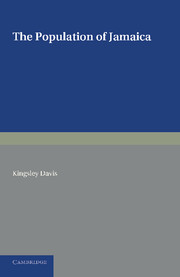Book contents
- Frontmatter
- The Conservation Foundation
- Contents
- List of Figures
- List of Tables
- Preface
- INTRODUCTION
- CHAPTER 1 DEMOGRAPHIC MATERIAL AVAILABLE
- CHAPTER 2 GROWTH OF THE POPULATION
- CHAPTER 3 MAJOR CHARACTERISTICS OF THE POPULATION
- CHAPTER 4 CURRENTS OF EXTERNAL MIGRATION
- CHAPTER 5 INTERNAL MIGRATION
- CHAPTER 6 MORTALITY
- CHAPTER 7 CHANGING PATTERNS OF REPRODUCTION
- CHAPTER 8 FERTILITY, MATING AND ILLEGITIMACY
- CHAPTER 9 GROWTH PROSPECTS
- APPENDICES
- Index of Names
- Index of Subjects
Preface
Published online by Cambridge University Press: 05 June 2016
- Frontmatter
- The Conservation Foundation
- Contents
- List of Figures
- List of Tables
- Preface
- INTRODUCTION
- CHAPTER 1 DEMOGRAPHIC MATERIAL AVAILABLE
- CHAPTER 2 GROWTH OF THE POPULATION
- CHAPTER 3 MAJOR CHARACTERISTICS OF THE POPULATION
- CHAPTER 4 CURRENTS OF EXTERNAL MIGRATION
- CHAPTER 5 INTERNAL MIGRATION
- CHAPTER 6 MORTALITY
- CHAPTER 7 CHANGING PATTERNS OF REPRODUCTION
- CHAPTER 8 FERTILITY, MATING AND ILLEGITIMACY
- CHAPTER 9 GROWTH PROSPECTS
- APPENDICES
- Index of Names
- Index of Subjects
Summary
This study, a formal demographic analysis of Jamaica, forms part of a broad research project sponsored by The Conservation Foundation. It is confined to the island of Jamaica; the dependencies— the Turks and Caicos Islands and the Cayman Islands—are not treated here because their vital statistics (which are not under the control of the Registrar General of Jamaica) are inferior to those of Jamaica.
As the last census of Jamaica was that of 1943 the analysis can in the main be carried no further than this date. However, in discussions of fertility and mortality full use is made of more recent data prepared by the Registrar General for years up to 1952. It remains an unfortunate but unavoidable consequence of the rapidly changing vital rates that any demographic study of the island tends to have dated somewhat by the time it is published.
Comparative material for other West Indian territories is drawn on where relevant historical and other factors suggest that the subject can be more satisfactorily developed in the wider context of the British Caribbean as a whole. Thus in Chapters 1, 4 and 7 material from other West Indian territories is used though in each case the focus of the analysis remains the population of Jamaica.
Some of the material used in this study has already appeared in papers published in Population Studies, and thanks are expressed to the editors of this journal for their permission to incorporate such material in the study.
The writer is most grateful to The Conservation Foundation, and in particular to its Director of Research, Mr R. G. Snider, for being selected to work on this study. The work was done under the direction of Professor Kingsley Davis and the writer remains deeply indebted to him for his guidance and encouragement at every stage. Special thanks are also expressed to Professor D. V. Glass for his critical reading of the manuscript; as a result of his criticism both the form and the content of the whole study have been improved.
- Type
- Chapter
- Information
- The Population of Jamaica , pp. xv - xviPublisher: Cambridge University PressPrint publication year: 2013



